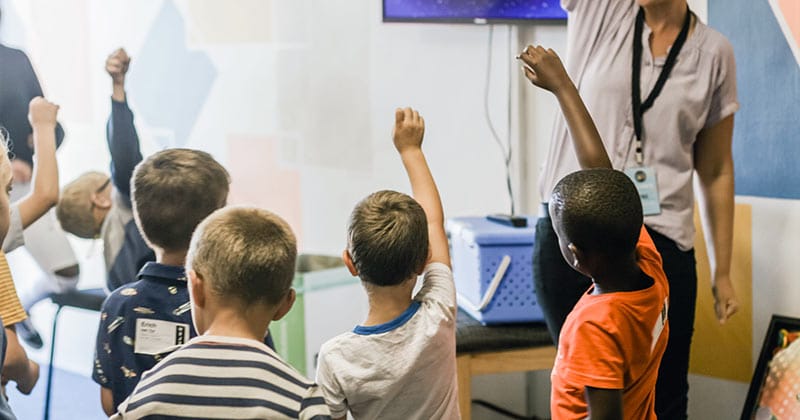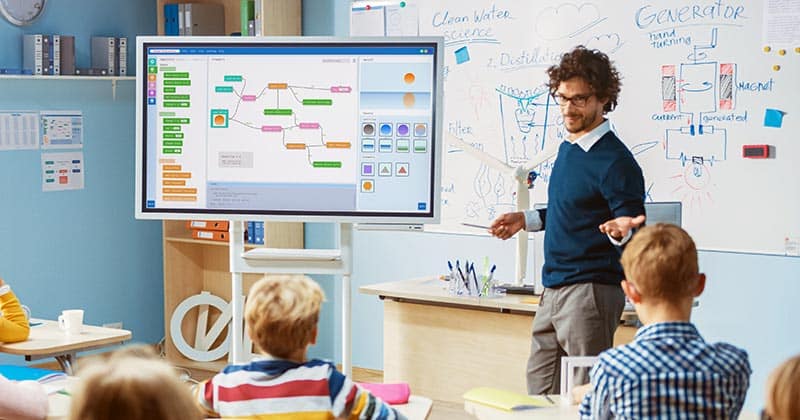Enhancing students’ soft skills is highly important in today’s job market. As a resource for the teachers of tomorrow, Future Educators recognizes the value of teaching these essential skills to students.
Let’s explore 21 effective ways of teaching soft skills to students, so they can thrive in their future careers. The article also provides a handy list of soft skills for students; abilities that future employers will want and expect.
From modeling active listening to hosting group discussion, here are practical ways teachers can develop the soft skills of their students.

Active listening is an essential soft skill. It enables individuals to grasp information, build relationships, and resolve conflicts. As an educator, you can shape students’ listening skills through methods and activities such as these.
- Create a supportive environment. Promote a classroom environment that supports attentive listening by fostering respect, empathy, and open-mindedness.
- Reflective thinking. Help students develop soft skills by encouraging them to reflect on what they’ve heard and consider different perspectives.
- Encourage students to listen. Encourage students to listen to one other during group discussions or pair-and-share activities.
- Give feedback. Offer constructive feedback to help students improve their listening skills.
- Model it. Demonstrate the behavior by giving full attention to students, and showing you understand and value what they’re saying.
- Practice sessions. Lead exercises to help students practice, such as paraphrasing or summarizing what another person just said.
Parents play a major role in fostering adaptability skills, which is tied in with resilience and experience at handling unexpected challenges. Educators can also teach the vital soft skill of adaptability. Here are some examples.
- Encourage experimentation and creativity. Give opportunities for hands-on projects. Encourage students to take risks and experiment with different approaches.
- Group discussions and debates. Engage students in group discussions and debates on controversial topics, where they consider multiple viewpoints and must be flexible in their thinking.
- Mindfulness and meditation practice. Students learn to stay calm and focused in challenging situations via mindfulness and meditation practices.
- Problem-based learning activity. Provide complex problems to solve. Students must work together to find a solution.
- Role-playing exercise. Students act out scenarios where, in response to new situations and perspectives, they must think creatively and be flexible in approach.

Communication skills are an important set of soft skills, impacting on many aspects of daily life and work. Good communication allows you to build relationships, pass on ideas and opinions, negotiate, solve problems, and given and receive feedback. Here are examples of how you can improve the communication skills of students.
- Group discussions and debates. Students participate in group discussions and debates on different topics.
- Oral presentations. Have students present in front of the class, helping to develop public speaking and verbal presentation skills.
- Role-playing exercises. Students act out scenarios involving high-level communication, such as job interviews, negotiations, and conflict resolution.
- Use technology. Take advantage of technology, such as video conferencing, to help develop contemporary communication skills.
- Writing activities and feedback. Ask students to write regularly, and provide feedback on their writing style, grammar, and how well they express their knowledge.
Conflicts and disagreements are a natural part of relationships. They can arise in personal, professional, and organizational settings. If left unresolved, conflicts can escalate, so damaging relationships, causing stress, and reducing productivity. Teachers can help develop conflict avoidance and resolution skills in students with the following methods.
- Group discussions and debates. Talk in small or large groups on controversial topics, where the goal is to hear each other out properly and find points of agreement where possible.
- Media analysis. Analyze media examples of disputes and settlements. Discuss how these examples can be applied to everyday situations.
- Problem-solving activities. Given students problem-solving activities that involve conflict resolution, such as team building exercises.
- Role-playing exercises. Students act out scenarios where they must negotiate, mediate, and resolve conflicts peacefully.

Armed with critical thinking skills, you’re better at assessing and communicating information, as well as a more adept problem solver and decision maker. Here are some ideas for teaching students to think in a more rational, thorough manner.
- Class discussion. Lead class discussions in which participants analyze information, arguments, and perspectives.
- Debates. Conduct debates on controversial topics in which evidence and logical arguments matter most. Identify deviations in critical thinking, such as anecdotes or moral presumptions.
- Encourage questioning. Encourage students to ask questions even when it may challenge conventional thinking.
- Problem-solving exercises. Give problem-solving tasks such as case studies or scenario-based exercises.
Creative ability is an important soft skill because it allows you to approach problems and challenges in a unique and original way, leading to more effective solutions and outcomes. Innovative thought helps you stand out and overcome challenges that might stump someone else. By cultivating creative thinking in students, educators prepare them for job success. Way to do it include the following.
- Brainstorming. Ask students to generate a large number of ideas and to think outside the box.
- Challenge students. Present students with real-world problems and challenges, and ask them to come up with creative solutions.
- Explore. Allow students to experiment, play, and explore new ideas in a low-stakes environment.
- Open-ended questions. Invite students to answer questions without placing too many parameters around them. Explore their ideas.

Being culturally competent allows someone to perform better in social, business or team situations where cultural barriers to understanding and communication may exist. Ways that educators can encourage the development of this soft skill include the following.
- Culturally rich content. Incorporate different cultures into curriculum and teaching materials, such as novels or film adaptions from writers Melina Marchetta or Chimamanda Ngozi Adichie.
- Cultural self appraisal. When appropriate, reflect on one’s own beliefs and assumptions and how they might shape perceptions.
- Talk about culture. Encourage students to learn about and appreciate the cultural backgrounds and perspectives of classmates.
Developing this soft skill requires you to better understand your own feelings and the feelings of others, communicate effectively, and build relationships with others. People with high emotional intelligence tend to be succeed in both their personal and professional lives. They’re able to handle challenging situations with empathy, self-awareness, and resilience.
Educators can help build emotional intelligence in students via practical methods such as:
- Emotion identification exercises. Students identify and label their own emotions, as well as the emotions of others, in different scenarios.
- Empathy building activities. Encourage students to put themselves in others’ shoes and consider how they would feel in different situations.
- Mindfulness exercises. Teach students mindfulness techniques, such as deep breathing and meditation, to help them regulate their emotions.
- Reflective journaling. Students reflect on their own emotions and experiences in writing. This can help them better understand their emotions and how to manage them.
- Role-playing. Have students act out scenarios that involve managing emotions and conflict resolution.
Interpersonal skills play a crucial role in relationships, enabling you to build trust, resolve conflicts, and achieve common goals. Someone with high skill forms positive relationships, networks, and works well in teams, all of which underpin personal and professional success.
Many of the other soft skills mentioned in this article go into the formation of a high level of interpersonal skill, including effective communication, empathy, listening, and teamwork. Other aspects are assertiveness and the ability to negotiate.
- Foster assertiveness. Teach students to express their opinions and feelings assertively and respectfully. They should be able to ask for what they need while also respecting others’ needs.
- Negotiation and compromise. Teach students how to resolve conflicts through compromise and negotiation. Provide opportunities to practice these skills in class discussions and group projects.
Leadership is important in many careers and life situations. Being able to lead enables you to effectively guide and direct others to achieve desired outcomes. You have the ability to create a positive and productive work or social environment.
Leadership can be taught through a combination of classroom instruction, hands-on learning experiences, and reflective activities. Here are some practical methods to cultivate leadership skills in students.
- Group projects and team-building activities. Students to work together to achieve a common goal. This will help them develop collaboration, communication, and problem-solving skills, which are all key components of effective leadership.
- Mentorship programs. Connect students with mentor leaders in their field of interest, allowing them to learn directly from experienced professionals.
- Leadership simulations. Use role-playing exercises or simulations to help students practice leading in a controlled environment.
- Public speaking and presentation opportunities. Students give presentations, whether in class or in a public setting, to help develop communication skills, self-confidence, and the ability to articulate ideas effectively.
- Reflection and self-assessment. Students reflect on their leadership experiences and assess their own skills and areas for improvement.
Being efficient, productive, and reliable are high-value qualities in the workplace and in life. Being well organized also has the potential to ease stress levels, and improve time management and your work-life balance. As an educator, you can help develop this skill in your classes.
- Schedules and plans. Ask students to keep a schedule and prioritize tasks.
- Set goals. Talk about goal setting and managing time.
- Role-play scenarios with your students, such as planning an event or managing a project.
- Incorporate project-based tasks in lesson plans that require students to plan their work.
- Self reflection. Give opportunities for students to reflect on and assess their organizational skills.
A positive attitude is considered an important soft skill because it impacts how one interacts with others and perceives challenges. People with positive attitudes tend to be more optimistic, resilient, and effective in managing stress and conflicts, which can lead to better relationships, improved problem-solving abilities, and greater success in personal and professional settings.
- Constructive focus. Encourage students to focus on their strengths and positive experiences.
- Role models. Showcase role models with positive attitudes.
- Gratitude. Provide opportunities for students to practice gratitude and appreciation.
- Action framing. Teach students to reframe problems as challenges and opportunities for growth.
- Encouragement. Foster a supportive learning environment that celebrates effort and progress.
Finding and implementing solutions to problems is a critical aspect of success in almost every field and industry, including business, healthcare, education, and more. Being able to solve problems improves decision-making, increases productivity, and helps people overcome obstacles and achieve goals.
- Brainstorming sessions. Lead group discussions to generate multiple solutions.
- Games and puzzles. Students solve challenging games and puzzles.
- Problem-based activities. Design activities that require students to identify and solve problems.
- Project-based learning. Students work on real-world projects that require problem-solving.
- Scenario-based discussions. Ask students to discuss possible solutions to hypothetical problems.
People who are high in self-awareness develop a sense of purpose, have improved decision-making skills, and are better able to manage their relationships. By contrast, a lack of self-awareness can result in ineffective communication, relationship problems, and difficulty recognizing one’s own strengths and weaknesses. You may also be less likely to learn from mistakes. To promote self-awareness, teachers can do these activities.
- Feedback sessions. Provide students with constructive feedback on their performance, both academically and socially, and encourage them to reflect on their behavior.
- Goal setting. Ask students to set achievable goals for themselves and regularly check in on their progress, which can help them take stock of where they’re at developmentally.
- Group discussion. Engage students in group discussions that encourage them to share their thoughts and perspectives on different issues, helping them gain a better understanding of their own beliefs and values.
- Mind mapping. Students create mind maps of their thoughts and ideas, which can help them better understand their own thinking processes.
- Personality assessment. Use personality assessments such as Myers-Briggs Type Indicator (MBTI) or the Big Five Personality Traits to help students identify their strengths, weaknesses, and tendencies.
Without self-motivation, individuals may struggle to get started on tasks or complete them in a timely and efficient manner. This reduces productivity and effectiveness while diminishing your opportunity to grow personally and professionally.
On the other hand, people with strong self-motivation achieve their goals, take on challenges, and continuously improve performance. They’re also more likely to be resilient in the face of setbacks and to maintain a positive attitude and work ethic.
Teaching self-motivation is challenging because it’s largely an internal quality that comes from within. However, there are a few practical ways to promote self-motivation in students.
- Goal-setting. Set achievable but challenging goals to motivate students to try harder.
- Hard work philosophy. Encourage students to work hard and persevere through difficulties. Help them understand that their hard work will pay off in the long run.
- Celebrate successes. Celebrating student successes and achievements, no matter how small, to build confidence and self-motivation.
Developing stress management skills can help individuals cope with stress and maintain a healthier, more balanced life. Excessive, poorly handled stress can lead to physical and mental health problems, reduced productivity, and diminished well-being.
- Talk about time management strategies that help students manage their workload and avoid feeling overwhelmed.
- Demonstrate chunking. Model the skill of chunking by breaking down a problem into smaller parts in front of your students. Show them how to identify the different components and develop a plan of action.
- Practice chunking. Give students real-world problems or issues to break down into smaller parts. Encourage them to work together in groups to brainstorm solutions and share their strategies.
